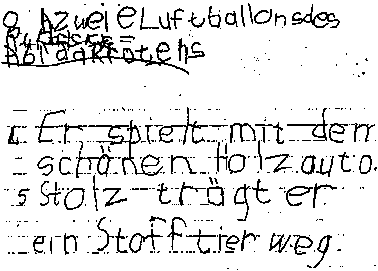| Magazine Home I Links I Contact Us |
|
Home |
Dysgraphia: Incidence, Characteristics, Warning Signs,
|
Introduction
Incidence
Characteristics
Warning Signs
Causes
Treatment
Most people never consider the complexity and difficulty of the writing process. In fact, relative to all other academic activities, writing requires more basic skills than perhaps any other.

Even during their earliest handwriting exercises, children must combine complex physical and cognitive processes to render letters precisely and fluidly. As writing tasks become more difficult, students must call on an increasingly wide range of skills to not only write legibly, logically, and in an organized way but also to invoke rules of grammar and syntax. This combination of requirements makes writing the most complex and difficult use of language.
Like all learning problems, a writing disability can be devastating to a child's education and self-esteem and can dramatically limit what that child can achieve later in life. School requirements demand a high level of writing proficiency, and a child who struggles with a writing disability will find it increasingly difficult to express his knowledge on many subjects, as the writing process itself will stand firmly in the way of learning.
The term dysgraphia is often used when discussing writing disabilities. Dysgraphia can refer to extreme problems with handwriting, spelling, and written composition. It can also refer to handwriting difficulties only.
We will use the first definition, and look at its subcategories of spelling, handwriting, and written composition. Some with a writing disability may experience difficulties in one or more of these areas.
Due to a lack of a clear-cut definition for dysgraphia and the dearth of research focused specifically on it, there are few statistics regarding prevalence. However, written language disabilities are very common in students with learning disabilities and they tend to be persistent.
Handwriting:
Combination of:
Types of graphomotor dysfunction:
Spelling:
Written Composition:
In Early Writers:
In Young Students:
In Teenagers and Adults:
As early as 1896 Baldwin noted that human learning is a stratified process. This implies that certain skills have to be mastered first, before it becomes possible to master subsequent skills. One has to learn to count before it becomes possible to learn to add and subtract. In the same way, there are skills that a student must have mastered first, before he or she will be proficient in writing. Unless underlying shortcomings are addressed first, the child's writing will not improve.
According to the website PBS.org, the following skills underlie the act of writing:
Language:
Language is an essential ingredient of writing. The ability to recognize letter sounds, comprehend words and their meanings, understand word order and grammar to construct sentences, and describe or explain ideas all affect a person's effectiveness as a writer.
Attention:
Writing often requires considerable mental energy and focus over long periods of time. Writers must not only preview what they want to convey but also continually monitor what they've already written to stay on track.
Spatial Ordering:
Children who struggle with spatial ordering have decreased awareness regarding the spatial arrangement of letters, words, or sentences on a page.
Sequential Ordering:
Children who struggle with sequential ordering have difficulty placing in order or maintaining the order of letters, words, processes, or ideas.
Memory:
The rate at which children generate ideas must coincide with their retrieval of necessary vocabulary, spelling, and prior knowledge, as they must be able to think about a topic, draw upon facts and concepts, and sequence ideas and facts in the right order.
Graphomotor:
Graphomotor function is the use of the neuromuscular system in the fingers and hands to effectively maneuver a pen or pencil and put letters and words on paper. Children with graphomotor problems struggle with this, especially as assignment length increases. This function affects a student's ability to keep pace with the flow of ideas.
|
The Audiblox Dysgraphia Program addresses the above-mentioned skills: It develops attention and concentration, spatial and sequential ordering, memory, and grahomotor function. The writing below belonged to an eight-year-old German boy with severe perceptual-motor problems. His parents started with intensive Audiblox training in April. The second example was taken from his schoolwork three months later.  |
| Home A B C D E F G H I J K L M N O P Q R S T U V W X Y Z |